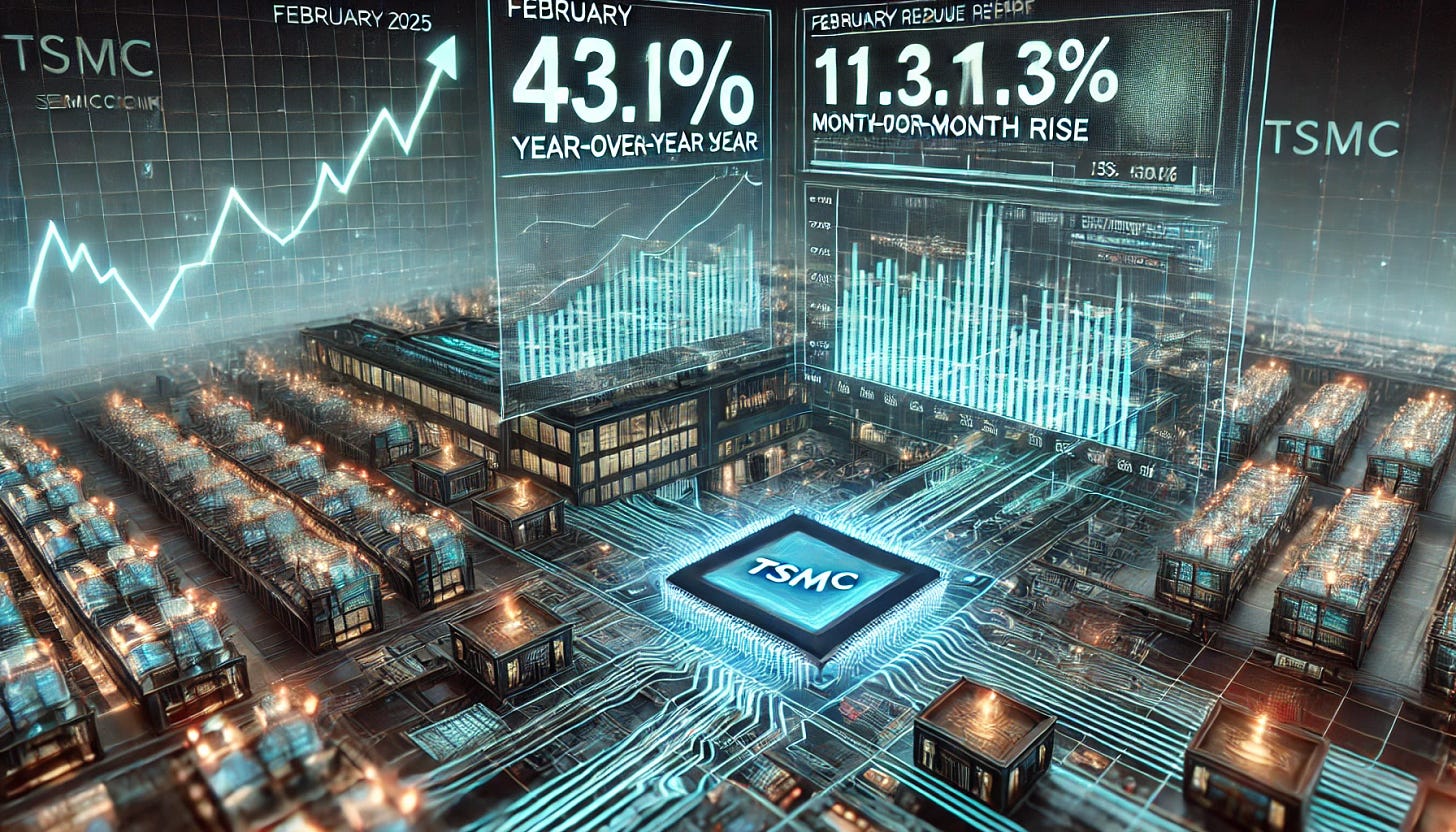🔮 Oracle Shatters Cloud Records with AI-Fueled Momentum
Welcome, AI & Semiconductor Investors,
Oracle just posted record-breaking cloud bookings driven by explosive AI demand, positioning itself as a central player in the AI infrastructure boom.
We also dive into TSMC’s mixed signals from its latest revenue report and AMD's leap into next-gen embedded processors.— Let’s Chip In
What The Chip Happened?
🔮 Oracle Shatters Cloud Records with AI-Fueled Momentum
✨ TSMC’s February Revenue Flex: Steep Monthly Dip, Stellar Yearly Rise
🔋 AMD Leaps Forward: 5th Gen EPYC Embedded Processors Emerge
[Oracle’s Q3 FY2025: Record Bookings and Accelerating AI Momentum]
Read time: 7 minutes
Oracle Corporation (NYSE: ORCL)
🔮 Oracle Shatters Cloud Records with AI-Fueled Momentum
What The Chip: On March 10, 2025, Oracle released its Q3 FY ’25 earnings, revealing a massive surge in bookings—up by a record-setting $48 billion—and a total remaining performance obligation (RPO) of $130 billion. From AI training deals to multi-cloud database expansion, Oracle’s cloud narrative continues to accelerate.
Details:
🤖 Soaring AI Demand: GPU consumption revenue jumped by 3.5x year-over-year, reflecting Oracle’s reputation as a top destination for both AI training and inference workloads. Larry Ellison noted, “Our technology runs faster and more economically than our competitors.”
☁️ Sky-High RPO: The company’s RPO hit $130 billion, a 63% increase year-over-year, signaling robust backlog demand for Oracle’s cloud services. Safra Catz highlighted, “This was our strongest booking quarter ever by a huge margin.”
🏭 101st Cloud Region Online: Oracle surpassed triple digits in its global data center footprint, with the milestone 101st region up and running. This expansion aligns with the expectation that power capacity will double this year and triple by the end of next fiscal year.
🏥 AI in Applications: Oracle is embedding AI “agents” into its apps (e.g., health care and Fusion), automating processes such as clinical documentation and expense management—driving larger deals in sectors like health care.
🤝 Multi-Cloud Flexibility: Oracle’s database now spans Azure, AWS, and Google Cloud, with 18 regions live and 40 more planned. The company sees triple-digit growth in its multi-cloud business as enterprises look to run Oracle DB across multiple clouds.
💰 Financial Highlights: Total cloud revenue rose 25% to $6.2 billion. Meanwhile, total Q3 revenue grew 8%, boosted by record AI-driven demand and strategic back-office SaaS applications. Oracle also increased its quarterly dividend by 25% to $0.50 per share.
🚧 CapEx Watch: Oracle expects FY ’25 CapEx around $16 billion—“a little more than double” last year’s—as it scrambles to meet booming AI and cloud capacity needs.
⚠️ Risks & Considerations: Supply chain challenges for GPUs, higher CapEx, and competitive pressures from other hyperscalers remain areas to monitor, though management projects faster-than-ever infrastructure growth in FY ’26 and beyond.
Why AI/Semiconductor Investors Should Care: Oracle’s Q3 performance underscores the colossal appetite for AI-centric infrastructure, from GPU-driven training clusters to real-time inferencing. With on-premise databases migrating en masse to the cloud and new AI data platform capabilities (Version 23ai) unlocking private data, Oracle is positioned to benefit from both high-margin SaaS and massive infrastructure demand. Investors in the AI and semiconductor spaces should track Oracle’s continued expansion as a vital indicator of market-wide cloud and GPU adoption trends.
Moore Semiconductor Investing
📗 [NEW!!] Unlock Q4 Semiconductor Earnings --- 60% OFF (NEW EARNINGS)
What The Chip: Get a front-row seat to the financials shaping the semiconductor industry. This continuously updated e-book by Jose Najarro distills the latest Q4 quarterly insights—from wafer production trends to AI chip breakthroughs—into a single comprehensive resource.
Details:
🔵 Dynamic Updates: Start with giants like TSMC and ASML, then expand to 30+ companies as their Q4 2024 earnings roll in. Earnings are restarting!!
🔵 Broad Coverage: From traditional chipmakers to cutting-edge AI semiconductor players, get the full picture as it emerges.
Why AI/Semiconductor Investors Should Care: This evolving earnings handbook gives you a strategic edge. Understanding quarterly earnings data is crucial for gauging industry health, discovering new growth leaders, and aligning your investment approach with emerging technological waves.
Disclaimer: For educational and informational purposes only. Not financial advice. Consult with a qualified professional before making any investment decisions. Updates are only for the Quarter of Earnings.
TSMC (NYSE: TSM)
✨ TSMC’s February Revenue Flex: Steep Monthly Dip, Stellar Yearly Rise ✨
What The Chip: TSMC just reported its February 2025 revenue on March 10, revealing a sizable 43.1% year-over-year jump to NT$260.01 billion. However, it also marked an 11.3% drop from January 2025, providing a mixed signal for investors.
Details:
🚀 Year-over-Year Surge: February revenue up 43.1% compared to last year—showing continued demand for TSMC’s advanced process nodes.
🤏 Month-over-Month Drop: A notable 11.3% decline from January, which management attributes partly to seasonal factors.
📊 Two-Month Snapshot: Combined January-February revenue reached NT$553.30 billion, up 39.2% from the same period in 2024—a strong start to the year.
💬 Management Commentary: “We remain optimistic about the long-term demand for high-performance computing and 5G-related solutions,” said TSMC CEO Dr. C. C. Wei.
🏭 Capacity Strategy: TSMC continues to expand overseas with new fabs in Arizona and Japan, aiming to secure global capacity leadership.
⚖️ Balancing Act: Investors watching potential inventory corrections across consumer electronics but also bullish on AI and data center spending.
Why AI/Semiconductor Investors Should Care: Despite a short-term revenue dip from January, TSMC’s impressive year-over-year growth underscores the ongoing demand for advanced nodes in smartphones, AI accelerators, and data centers. The company’s strong position in next-generation chipmaking technologies keeps it at the heart of the global semiconductor supply chain, making TSMC a crucial bellwether for the entire industry.
AMD (NASDAQ: AMD)
🔋 AMD Leaps Forward: 5th Gen EPYC Embedded Processors Emerge
What The Chip: On March 11, 2025, AMD unveiled its new 5th Gen AMD EPYC™ Embedded 9005 Series processors, powered by the “Zen 5” architecture. These CPUs target networking, storage, and industrial edge markets, promising higher performance, greater efficiency, and extended product lifecycles.
Details:
🚀 High Core Density: Offering up to 192 cores in a single socket, AMD claims a 1.3X to 1.6X boost in data processing throughput for networking and storage workloads. This helps tackle complex AI-driven network traffic and exploding data requirements.
⚡ Better Efficiency: The “Zen 5c” core architecture aims for up to a 1.3X boost in socket throughput and 1.3X better performance per watt versus competitive solutions. With up to 6TB of DDR5 memory and up to 160 PCIe Gen5 lanes, the processors focus on both speed and scale.
🏗️ Longevity & Reliability: AMD commits to 7-year product manufacturing support and extended design lifetime targets—critical for embedded markets that run in 24/7 environments. Additional features like Non-Transparent Bridging and DRAM Flush address system resiliency and data protection.
🔒 Security Features: Dual SPI support allows a secure, proprietary bootloader for trusted execution environments. These security enhancements help protect hardware in mission-critical deployments.
🌐 Ecosystem Backing: Cisco’s Director of Product Management, Lukasz Bromirski, highlighted the scalability (up to 192 cores) and reliability for high-end firewall products, while IBM’s Matthew Geiser called out the strong redundancy features for data-intensive AI workloads in IBM Storage Scale System 6000.
⏰ Market Availability: Currently sampling with early-access customers, AMD expects volume production to start in Q2 2025. The new chips are socket-compatible with 9004 Series, easing upgrade paths.
Why AI/Semiconductor Investors Should Care: These processors underscore AMD’s strategic push into high-performance, long-lifecycle embedded markets—core segments for networking, data center, and industrial edge growth. By offering improved performance-per-watt and a robust technology ecosystem, AMD aims to solidify its position against competitors, making this launch significant for investors tracking AI and semiconductor innovation.
Youtube Channel - Jose Najarro Stocks
[NEW] Semiconductor Q4 Earnings Book — 60% OFF
X Account - @_Josenajarro
Disclaimer: This article is intended for educational and informational purposes only and should not be construed as investment advice. Always conduct your own research and consult with a qualified financial advisor before making any investment decisions.
The overview above provides key insights every investor should know, but subscribing to the premium tier unlocks deeper analysis to support your Semiconductor, AI, and Software journey. Behind the paywall, you’ll gain access to in-depth breakdowns of earnings reports, keynotes, and investor conferences across semiconductor, AI, and software companies. With multiple deep dives published weekly, it’s the ultimate resource for staying ahead in the market. Support the newsletter and elevate your investing expertise—subscribe today!
[Paid Subscribers] Oracle’s Q3 FY2025: Record Bookings and Accelerating AI Momentum
Executive Summary
*Reminder: We do not talk about valuations, just an analysis of the earnings/conferences
Oracle Corporation (NYSE: ORCL) closed its third quarter of fiscal year 2025 (Q3 FY2025) on March 10, 2025, reporting strong results underpinned by hefty bookings, record cloud demand, and continued expansion in artificial intelligence (AI) workloads. The company, known for its cloud solutions, enterprise software, and database offerings, reported total revenues of USD 14.1 billion, an increase of 6% in USD and 8% in constant currency compared to the same quarter last year. Oracle’s leadership cited the company’s growing pipeline in cloud infrastructure (OCI) and AI-related services as the primary catalysts behind a surge in its Remaining Performance Obligations (RPO), which rose to USD 130 billion—a 63% constant currency year-over-year increase.
Chairman and Chief Technology Officer (CTO) Larry Ellison and Chief Executive Officer (CEO) Safra Catz both highlighted the robust demand for Oracle Cloud Infrastructure (OCI), fueled by AI training and multi-cloud database workloads. Oracle executives also noted their success in signing long-term contracts with major technology partners, including AMD, NVIDIA, and OpenAI. On the call, Safra Catz stated, “As you can see, this was our strongest booking quarter ever by a huge margin as we added USD 48 billion to our backlog.” Additionally, Oracle increased its quarterly dividend by 25%, to USD 0.50 per share, reflecting its confidence in cash flow generation.
Key metrics from Q3 FY2025 included:
Cloud Revenue (SaaS + IaaS): USD 6.2 billion, up 25% in constant currency
Infrastructure-as-a-Service (IaaS) Revenue: USD 2.7 billion, up 51% in constant currency
Software-as-a-Service (SaaS) Revenue: USD 3.6 billion, up 10% in constant currency
Total Revenue: USD 14.1 billion, up 8% in constant currency
Non-GAAP EPS: USD 1.47, up 7% in constant currency
Looking ahead, Oracle remains focused on meeting mounting AI-driven demand for both training and inferencing needs. With data center capacity expected to double this calendar year and triple by the end of next fiscal year, management shared a cautiously optimistic view that new GPU-powered cloud regions will feed accelerated revenue growth in the near term.
Growth Opportunities
AI Training and Inferencing
Oracle pointed to soaring bookings for AI workloads in the cloud. Ellison mentioned a forthcoming “Stargate” project that is expected to involve “the biggest AI training project out there,” though details about precise financial flows will likely emerge in subsequent quarters. Current GPU consumption for AI training is already 3.5 times higher than a year ago, and Oracle plans to deploy thousands more NVIDIA and AMD GPUs to meet continued demand.







